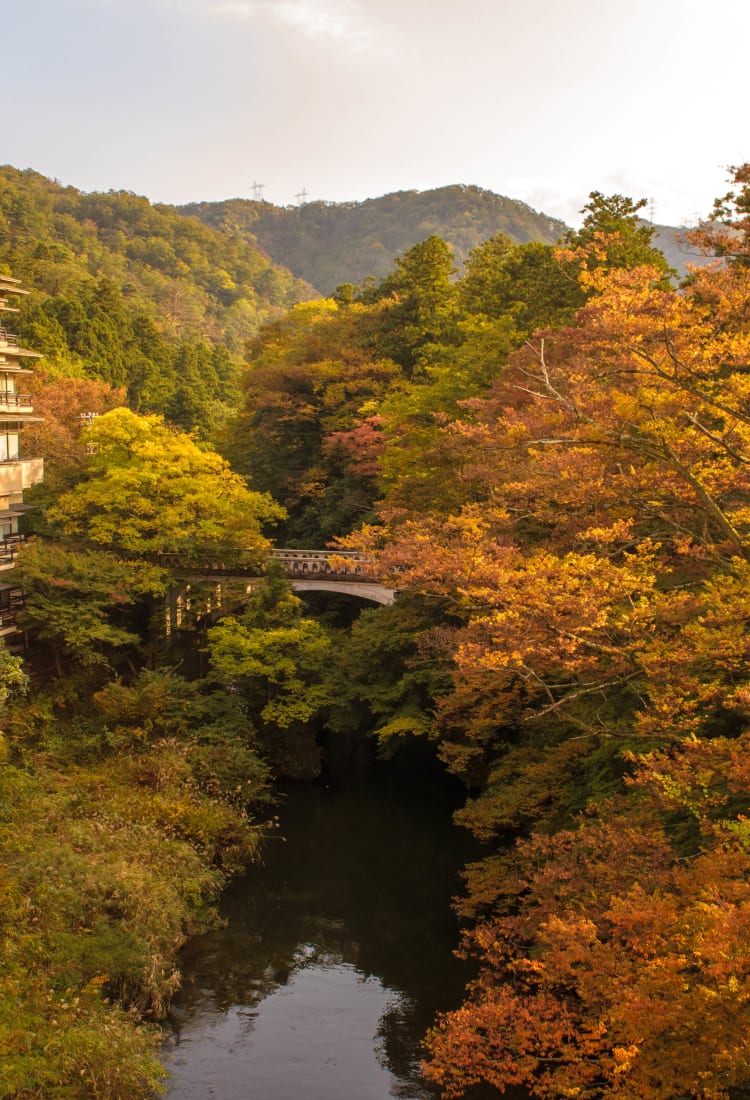

ISHIKAWA Kaga & Around Historical hot spring villages, exquisite natural beauty, and traditional crafts
Historical hot spring towns, exquisite natural beauty, and traditional crafts
The Kaga area is blessed with the scenic beauty of the ocean, quaint hot spring resort towns, rustic mountain villages, and the dramatic peaks of the Hakusan Mountain Range. In addition to its natural beauty, Kaga is a place where traditional Japanese crafts continue to thrive.
Don't Miss
- Relaxing in the various historical and modern hot spring bathhouses
- A hike up one of Japan's most holy mountains
- The abundance of traditional art and local crafts
- A road trip around the Hakusan National Park in either the summer or the fall
How to Get There
Kaga Onsen Station is the central hub of the area. Another access point is Komatsu Airport, to the north of the city of Kaga, which offers both domestic and international flights.
Flights are available from Haneda, Narita, Sapporo, and other domestic airports around Japan to Komatsu Airport. There are also international flights from Taiwan, Shanghai, and Seoul. From the airport, Kaga Onsen Station is a 30-minute ride on the local bus service, CANbus, or a 25-minute taxi ride.
Alternatively, JR Hokuriku bullet trains have connecting trips from Tokyo to Kanazawa in 2.5 hours, and JR limited express trains offer connecting trips from Kaga Onsen to Kanazawa in 25-30 minutes. The JR limited express Thunderbird connects Osaka and Kyoto to Kaga Onsen in 2.5 hours.
Return to a slow-paced life in southern Ishikawa
Kaga makes up the south part of Ishikawa , with Fukui Prefecture bordering to the south and Gifu Prefecture to the east. Kaga is the perfect place to stop and relax after visiting Kanazawa. Learn about the development of Kutani yaki porcelain, sample the local specialties, and venture into the mountains.
Take a bath, Japanese style
If you want to experience the famed Japanese hot spring waters and their healing minerals, spend time in Kaga Hot Spring Area , conveniently accessible by the Kaga Hot Springs Area CANbus on both the mountain route and the sea route.

Explore the highly praised hot spring villages
Each of the four villages that make up Kaga Onsen City has its own distinct character, and each has its own soyu, or public bath, in the center of town.
Katayamazu Onsen is located on a small lagoon lake by the sea, featuring a modern glass public bath overlooking the ocean. Inland, on the opposite side of Kaga Onsen Station, is Yamashiro Onsen , where you can take a dip in baths that are decorated as if they were from the Meiji Era (1868-1912). Further into the mountains is Yamanaka Onsen, where the waters were once praised by the famous poet Matsuo Basho as some of the best in Japan. The village is also renowned for Yamanaka lacquerware and woodturning. At Awazu Onsen, stop at the sacred Natadera Temple before soaking in the soyu.


The birthplace of Kutani yaki ceramics
In the southern district of Daishoji, a small castle town with a temple, you will find the Kutaniyaki Art Museum where different examples of painted porcelain are displayed over two floors. There are also gardens surrounding the museum.
Famous for winter snow crab
The port town of Hashitate, located just 10 minutes west of Katayamazu Onsen , is a leading fishing port where a vast array of seafood is offloaded. The incredibly fresh winter snow crab is particularly famous here.
Challenge yourself with a holy mountain climb
Mt Haku, or Hakusan, straddles the border between Ishikawa and Gifu in the southern part of Kaga. The hiking trails are officially open from July to October, and during the hot summer months, you will find local hikers escaping the heat on the peaks. With good weather, you can see panoramic views of the Japanese Alps and the Sea of Japan from the summit.
Road tripping
Rent a car and travel along the well-maintained Hakusan Shirakawago White Road. This scenic drive is spectacular in the fall, when the trees on the mountainside change to bright red, yellow, and orange hues. The winding road offers views of Mt Haku and of several waterfalls cascading down the mountainous terrain. There is also a hiking trail to a 1,736-meter peak.
Continuing the journey
For further exploration of the region, travel to nearby Fukui Prefecture, which is home to the Eiheiji Temple, one of the main temples of the Soto school of Zen Buddhism. Another feature of the area is the impressive Fukui Prefectural Dinosaur Museum.






























































